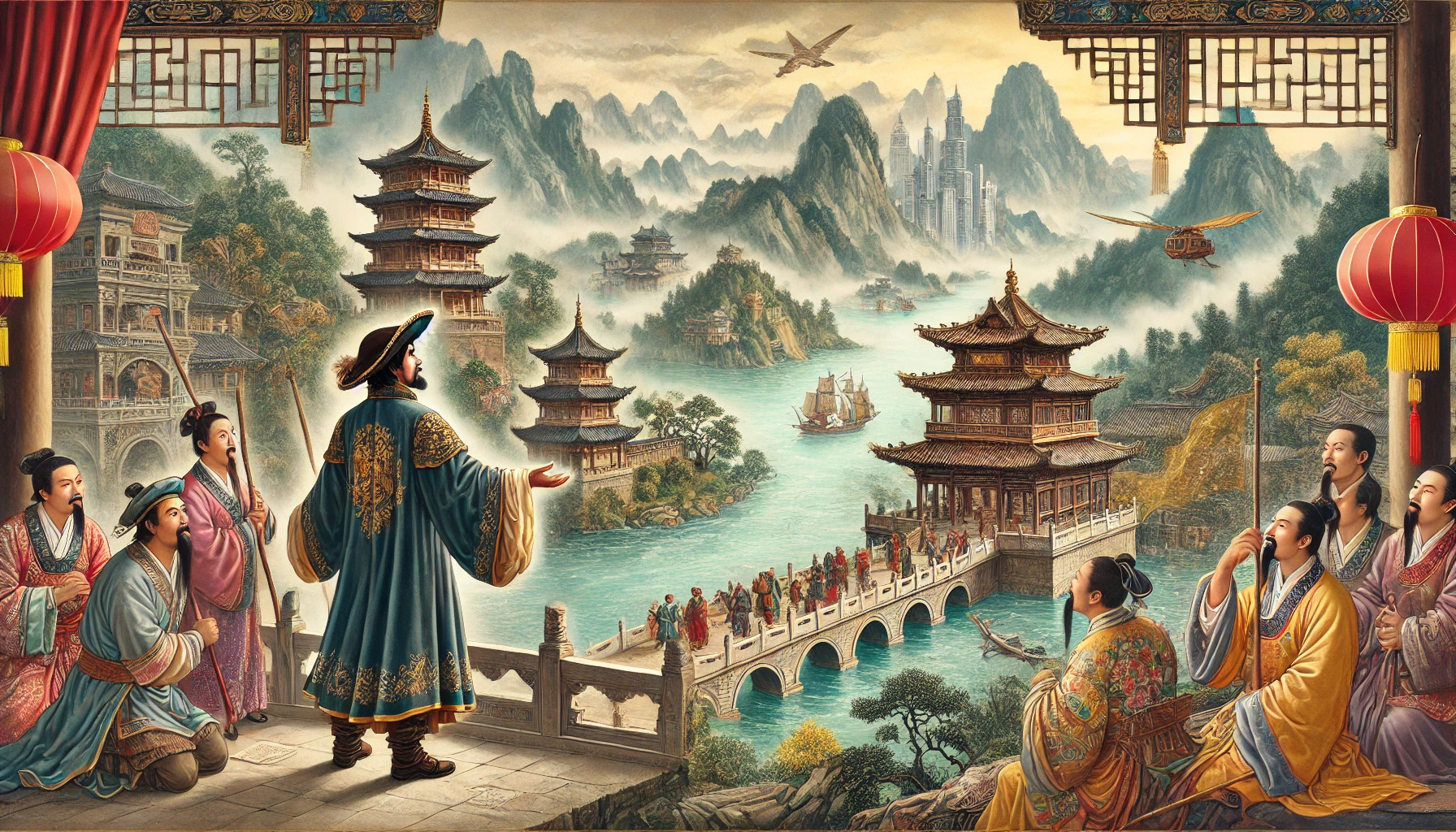
Illustration by DALL·E of Marco Polo discovering China
East and West
In the conceptualisation of the advent of artificial intelligence on a par with human intelligence, there are major differences between the West and the East: between the civilisations and the range of cultures born, on the one hand, in the Fertile Crescent and, on the other, around the Pacific Rim.
The tradition in the East is to assume that the essence of the world is very close to what we spontaneously perceive of it. The philosopher Alexandre Kojève has pointed out that, apart from a few marginal manifestations, the Far East has remained firmly atheist throughout the ages. Referring to Buddhism, the only truly historical religion in the region, he writes that it is a radical atheism: ‘an atheism in the radical sense that I have put forward’ 1.
The world as conceived by the East needs to be maintained, and it is humanity’s duty to keep it in good working order. Hence, in Confucianism, the respective duties of the sovereign (Heaven) and the people (Earth). In the same cultural era, the Intichiuma ceremony of certain Aborigines of Central Australia is also akin to this, in which the active forces of the tribe are summoned and mobilised in an annual festival designed to ensure, through a gathering of resources, songs, dances and proclamations, the rebirth and perpetuation of the productivity of the natural world as we observe it in its permanent abundance and fertility in plants and animals (see Durkheim 2).
The West, for its part, has a tradition of asserting that the world is essentially very different from the way it manifests itself to the candid observer, either because in the context of its religions it focuses its attention on an afterlife situated in a Beyond of better quality than the world here below, the nature of which is revealed to us by theologians, or because, within the discourse of ‘science’, they assume an Objective Reality underlying the empirical world, constituting its innermost being and whose true functioning scientists are able to describe and explain through the development of their theories.
In the West and in the East, two very different paths were taken from the earliest days in the gradual construction of a representation of the world: the Western vision, which consists of aggregating the elements of the world into ‘kinds’ on the basis of their external, essentially visual, similarity, and the Eastern vision of assembling under a single token phenomena eliciting a similar emotional response. Ian Saem Majnep, a Papuan from New Guinea, and Ralph Bulmer, a British anthropologist, report that among the Kalam, Majnep’s native tribe, certain birds are grouped together because they provoke in humans a fright experienced as of the same nature 3.
Fundamental differences exist also between the East and West in the conception of interconnectedness between different kinds of things: the East having chosen to concentrate on the affinities of similar kinds linked in a symmetrical mutual relationship, each standing as a sign for the other in a world essentially made up of correlations, the West having, by contrast, concentrated on the asymmetry of kinds where some are included in others and where some are the causes of others which are their effects. The East conceiving thus a world under the aegis of the “and” with kinds linked statically in space and cyclically in time, recurring in the same mutual relationship through a chain of elementary connections, whereas the West conceives of the world as fully organised and interpretable by the “therefore” in a dynamic landscape of an irreversible becoming.
After having first known of each other in the thirteenth century notably thanks to Marco Polo’s travels, these two worldviews began to slowly cross-fertilise in the sixteenth century, the vision entertained by the West largely prevailing due to the fact that a causally interconnected world representation enables technological inventions in an applied science perspective rooted in theoretically inspired modelling, as opposed to what had previously only been achievable, namely a technology relying for its development solely on trial and error.
=============
1 Kojève, Alexandre, L’athéisme, Paris: Gallimard 1998, p. 75
2 Durkheim, Émile, Les formes élémentaires de la vie religieuse. Le système totémique en Australie [1912] Paris: PUF 1968, pp. 465-500
3 Majnep, Ian Saem & Ralph Bulmer, Birds of my Kalam Country, Auckland University Press – Oxford University Press 1977

Illustration by DALL·E of the Intichiuma ceremony